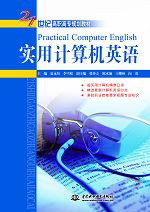实用计算机英语

-
【作 者】夏永恒 李雪松
【I S B N 】978-7-5084-6739-9
【责任编辑】陈艳蕊
【适用读者群】高职高专
【出版时间】2009-08-01
【开 本】16开
【装帧信息】平装(光膜)
【版 次】第1版第1次印刷
【页 数】
【千字数】418
【印 张】18.75
【定 价】¥32
【丛 书】21世纪高职高专规划教材
【备注信息】
简介
本书特色
前言
章节列表
精彩阅读
下载资源
相关图书
本书大部分内容都和日常使用的计算机密切相关,实用性强。书中内容有的是从一些计算机设备说明书中摘录的,有的是从软件使用手册或帮助中精选的,甚至有些内容是从软件的界面上选取的。通过学习本书可以在将来更好地理解计算机相关设备的使用和软件的操作等。此外,本书还增加了对话内容,让读者在学习计算机英语知识的同时,还可以了解在面试求职、产品讨论等方面计算机类英语口语的表达。每节设有“Warm-up”部分,通过提出问题让读者在阅读本书时有一定的目的性,并给本节内容做一个铺垫。
本书主要适合高职高专类计算机相关专业的学生使用,同时也可作为本科类专业的辅助教材,还可以作为计算机类相关职业培训的教材。
计算机技术作为一项时代性科技,其飞速的革新变化需要有强烈的创新力量来支持。随着越来越多的计算机新技术的运用,计算机专业人员需要有良好的专业英语水平来及时了解并掌握技术发展的新动向。
本书针对计算机应用及相关专业高职高专院校学生的学习水平、能力和计算机实践需要,通过创新的教材编写形式使学生掌握计算机专业英语的基础知识和最新技术,提高计算机综合运用水平。
本书编写的主要特点是所有的文章均为科技类,不仅知识内容丰富,并且针对高职高专教学特点,做到了深入浅出,通俗易懂。每一章节除了正文外,还增加了对话练习、热身训练、附加阅读、练习题四个方面的内容。通过互动形式,进一步开拓学生的听、说、读、写能力,丰富了教学手段。尤其是附加阅读内容时效性、专业性强,既可以作为教师的课堂讲述内容,也适合学生作为补充材料阅读。此外,书中还配以大量的教学图例,使学生能够直观、简明地了解学习内容,增强实操能力。书后附有所有文章的参考译文,以及附录词汇表,包括专业词汇、词组以及专业缩略词的部分音标和解释,方便教师和学生查阅使用(由于篇幅有限,参考译文请登录中国水利水电出版社网站或万水书苑免费下载,网址:http://www.waterpub.com.cn/ softdown/或http://www.wsbookshow.com)。
本书共分9章,为了方便教师安排教学计划,每章分为4小节,每一小节都是完整独立的。第1章计算机基础,作为一个概要统领全书内容,介绍了计算机硬件、软件、基本的算法结构和网络方面的基础知识。第2章操作系统,介绍了操作系统的基本原理和功能的相关知识以及时下流行的一些操作系统的特点、种类等,尤其是对Linux做了着重说明。第3章数据库,介绍了数据库系统的基本原理,结构化查询语言以及数据仓库的相关概念。第4章多媒体,介绍了多媒体并行处理技术,Photoshop以及计算机动画制作相关的历史和技术。第5章计算机语言,介绍了计算机常用的程序设计语言及其算法知识。第6章计算机网络,介绍了计算机网络设备、协议和结构等方面的基础原理和架构。以最新的Web 2.0为例详解了计算机网络以及相关协议的实践应用。第7章网络安全,介绍了计算机网络安全的主要隐患和防范方法,对现今最受瞩目的计算机病毒和网络防火墙做了详尽地介绍。第8章互联网与电子商务,介绍分析了互联网和电子商务的基础原理。第9章软件工程,介绍了软件工程基础和软件开发实践中生命模型原理和实践分析。
本书由具有多年教学经验的计算机和英语教师联合编写。夏永恒、李雪松任主编,张传立、陈水池、丰继林、向勇任副主编,吕顺琴、陈水池、邓建农负责编写第1章第1、3节、第5章第1、2、3节,张焱、陈水池、李雪松编写第1章第2节、第2章1、2、3节、第9章,张传立、陈水池、于凤编写第1章第4节、第2章4节、第6章,张继红、夏晓、孙静编写第3章、第7章,王克难、夏晓编写第4章,潘静红、邓建农、孙静编写第5章第4节、第8章。参加本书编写的还有李凤、黄智等老师,在此一并表示感谢。
为了方便教学,本书另配有电子教案和课后习题答案,向选用本书作为教材的教师免费提供(获取方式:请发送电子邮件到zhangchuanli@bjjtxy.bj.cn)。
由于编者水平有限,书中错误在所难免,敬请读者批评指正。
编 者
2009年9月
Chapter 1 Computer Fundamentals 1
Section 1 Computer Hardware 2
Dialogue 2
Warm-up 2
Text 3
Exercises 7
Reading 1 8
Reading 2 9
Section 2 Computer Software and Categories 14
Dialogue 14
Warm-up 14
Text 15
Exercises 16
Reading 1 17
Reading 2 18
Section 3 Data Structure and Algorithms 20
Dialogue 20
Warm-up 20
Text 21
Exercises 23
Reading 1 24
Section 4 Computer Networks 30
Dialogue 30
Warm-up 30
Text 31
Exercises 33
Reading 1 34
Reading 2 34
Chapter 2 Operating System 38
Section 1 Introduction to Operating System 39
Dialogue 39
Warm-up 39
Text 39
Exercises 41
Reading 1 42
Section 2 Functions of Operating System 49
Dialogue 49
Warm-up 49
Text 50
Exercises 51
Reading 1 52
Reading 2 53
Section 3 Popular Operating Systems and Structures 55
Dialogue 55
Warm-up 55
Text 56
Exercises 58
Reading 1 59
Reading 2 60
Section 4 Linux and Networking Operating
System 63
Dialogue 63
Warm-up 64
Text 64
Exercises 66
Reading 1 66
Chapter 3 Database 70
Section 1 Parts of a Database 71
Dialogue 71
Warm-up 71
Text 72
Exercises 75
Reading 1 76
Reading 2 78
Section 2 Relational Database Components 81
Dialogue 81
Warm-up 81
Text 81
Exercises 84
Reading 1 85
Reading 2 87
Section 3 Database Architecture 89
Dialogue 89
Warm-up 89
Text 89
Exercises 92
Reading 1 93
Reading 2 94
Section 4 Data Warehouses Overview 97
Dialogue 97
Warm-up 97
Text 97
Exercises 100
Reading 1 101
Reading 2 103
Chapter 4 MultiMedia 106
Section 1 About Masks and Alpha Channels 107
Dialogue 107
Warm-up 107
Text 107
Exercise 110
Reading 1 111
Reading 2 113
Section 2 Main File Formats in Photoshop 115
Dialogue 115
Warm-up 115
Text 115
Exercise 118
Reading 1 119
Reading 2 121
Section 3 Computer Animation 123
Dialogue 123
Warm-up 123
Text 123
Exercise 124
Reading 1 125
Reading 2 126
Section 4 Creating Your Own Web Page
Graphics 128
Dialogue 128
Warm-up 128
Text 128
Exercise 130
Reading 1 131
Reading 2 131
Chapter 5 Programming Language 133
Section 1 Introduction to Programming
Language 134
Dialogue 134
Warm-up 134
Text 134
Exercises 138
Reading 1 139
Reading 2 141
Section 2 Procedural Programming 144
Dialogue 144
Warm-up 144
Text 145
Exercises 146
Reading 1 147
Reading 2 150
Reading 3 153
Section 3 Java Programming Language 157
Dialogue 157
Warm-up 157
Text 157
Exercises 161
Reading 1 162
Reading 2 165
Reading 3 169
Section 4 .NET Framework 172
Dialogue 172
Warm-up 172
Text 172
Exercise 174
Reading 1 175
Chapter 6 Computer Network 178
Section 1 Network Devices 179
Dialogue 179
Warm-up 179
Text 180
Exercises 182
Reading 1 183
Reading 2 184
Section 2 Network Protocol 185
Dialogue 185
Warm-up 185
Text 186
Exercises 187
Reading 1 188
Section 3 Network Architecture 191
Dialogue 191
Warm-up 192
Text 192
Exercises 194
Reading 1 195
Reading 2 196
Section 4 Web 2.0 198
Dialogue 198
Warm-up 199
Text 199
Exercises 200
Reading 1 201
Reading 2 203
Chapter 7 Network Security 206
Section 1 Security Attack 207
Dialogue 207
Warm-up 207
Text 207
Exercises 210
Reading 1 211
Section 2 Model for Network Security 214
Dialogue 214
Warm-up 214
Text 214
Exercises 216
Reading 1 217
Section 3 Malicious Programs 220
Dialogue 220
Warm-up 220
Text 221
Exercises 223
Reading 1 224
Section 4 Security Services 226
Dialogue 226
Warm-up 226
Text 226
Exercises 228
Reading 1 229
Chapter 8 Internet and E-commerce 232
Section 1 Internet 233
Dialogue 233
Warm-up 233
Text 233
Exercise 234
Reading 1 235
Section 2 E-commerce 238
Dialogue 238
Warm-up 238
Text 238
Exercise 239
Reading 1 240
Section 3 E-commerce Careers 242
Dialogue 242
Warm-up 242
Text 242
Exercise 245
Reading 1 246
Section 4 E-commerce-How It Works 248
Dialogue 248
Warm-up 248
Text 248
Exercise 251
Reading 1 252
Chapter 9 Software Engineering 256
Section 1 Why Software Engineering? 257
Dialogue 257
Warm-up 257
Text 257
Exercises 260
Reading 1 261
Section 2 Modeling the Process Life Cycle 265
Dialogue 265
Warm-up 265
Text 266
Exercises 269
Reading 1 270
Reading 2 274
Glossary 277
Computer Terms 289
Abbreviations 291
Bibliography 293

